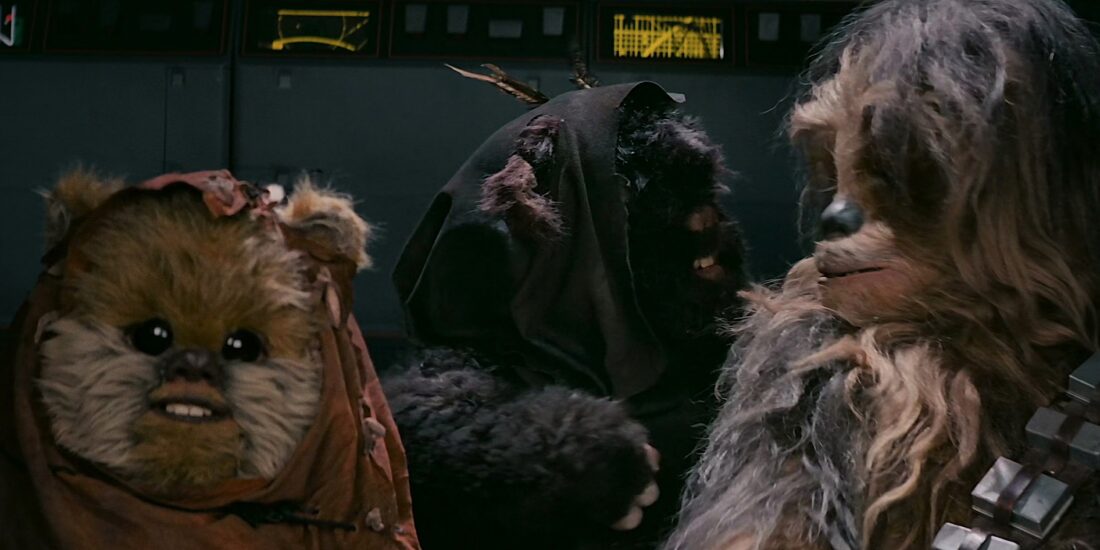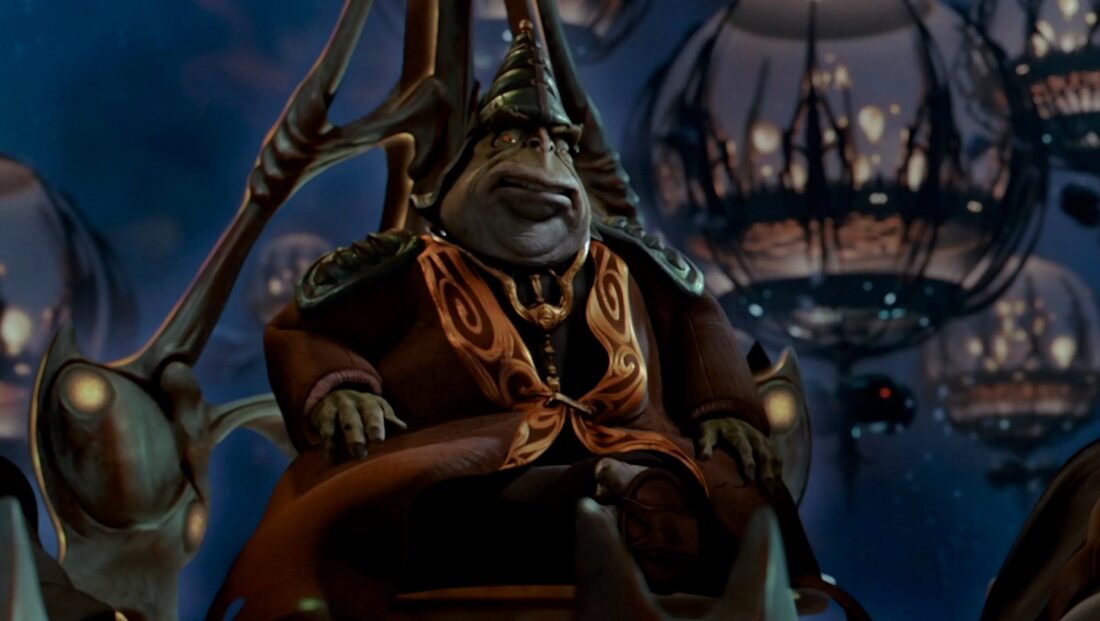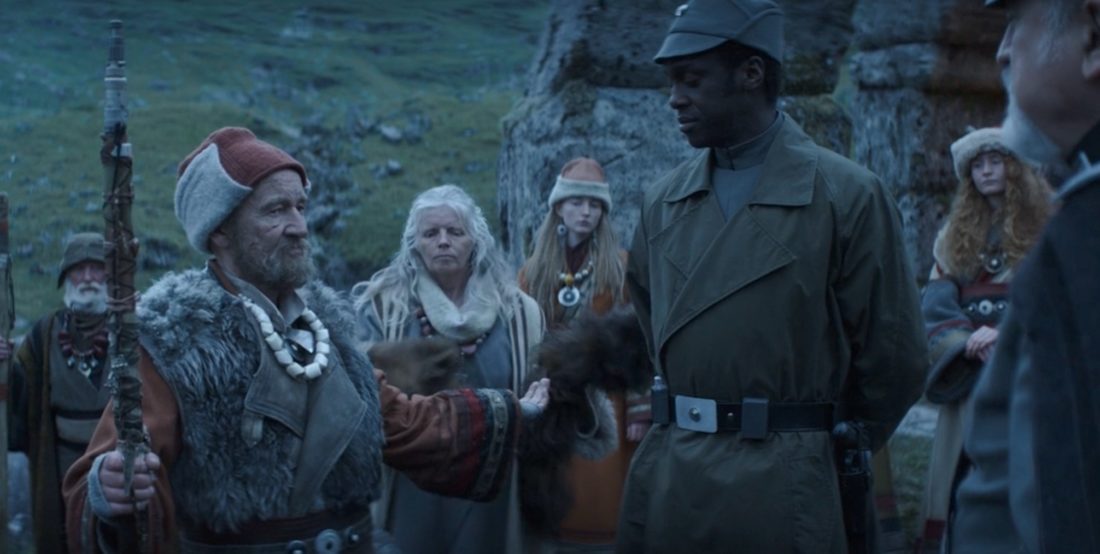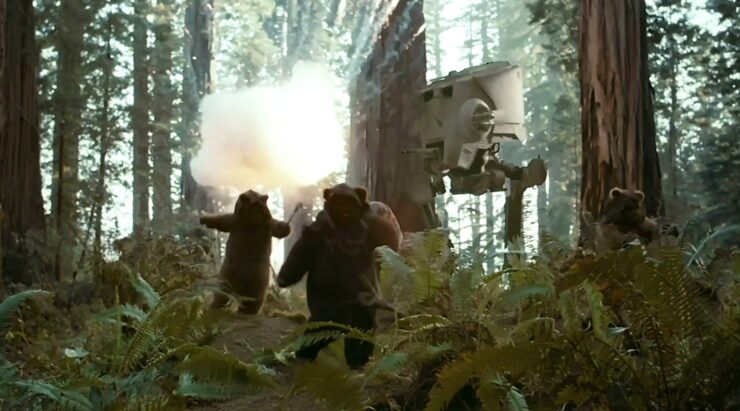Out of the cold, sterile setting of space, we, the audience, are dropped anxiously into a lush and verdant world. The enemy (Vader) is aware of the presence of our heroes (Luke, Han, and Leia), but lets them pass anyway. It’s tense, and we expect a skirmish at any moment, but we’re given time to appreciate our new surroundings—towering forests and a carpet of thick undergrowth. What must this unexplored land contain?
The planets in Star Wars often act as exotic and undiscovered backdrops, appropriately strange or vibrant or lawless, for these space opera stories to feel firmly distanced from our own humdrum world. And within these backdrops we encounter inhabitants, be it an Ewok, Gungan, loth-wolf or the notorious Sarlacc, whose significance are sometimes lost in the chaos of the story. This might lead the viewer to see them as unfortunate passive bystanders, the day’s host of a galactic-wide struggle. However these peoples and species rarely take on passive roles, but often demonstrate agency that is crucial to the success of our heroes. They are continually underestimated by the Empire and yet their knowledge and actions are often the tipping point to success. (Well, maybe not the Sarlacc.)
Star Wars frequently highlights the unique strengths of indigenous peoples, native fauna, and even location-specific cosmic phenomena in all canon and non-canon stories. This theme pops up again and again, often shown at the critical moment when our heroes need assistance the most. They are added muscle behind the punch or facilitate a knife-edge escape. In fact, there are many examples where it’s doubtful the victory would have gone to our heroes at all if it weren’t for the participation of these groups. Native power is woven deeply into the fabric of the Star Wars universe and extends beyond the occasional backup in battle, representing an active choice of resistance. While this support is often interpreted as Jedi vs. Sith or light side vs dark side, this view can be reductive toward the involvement of indigenous and native groups on the planets where these struggles are fought.

Perhaps the most well-known example of this are the Ewoks in Return of the Jedi, whose key attack caught the Imperials off guard and generated enough bedlam and distraction to give Han and Leia time to break into the Imperial bunker and turn off the shield generators to the second Death Star. What began as comic relief in the capture of Luke and Han, and the worship of C-3PO as a god turned into the clinch-pin of the entire operation, the fate of the galaxy resting on the decision of the Ewoks to resist. In the minds of audiences, Endor and Ewoks become synonymous. The Rebellion may have started the fight, but it was the Ewoks who finished it, assuring victory over the Empire.
Let’s examine this theme from another angle. The glittery, crystal-coated ice fox called a vulptex seen on the planet Crait at the end of The Last Jedi. As Kylo Ren finishes raging at Luke’s Force projection, our rebels are spirited away to the back of the cave by the vulptices and, with Rey’s help, make a timely escape. The blindly crushing force of the First Order is too cumbersome to match the knowledge of the landscape and swift agility of the vulptices. I particularly like this example, because it demonstrates the extent that Star Wars relies on this theme across a wide agency spectrum. The vulptex species do not speak, they have (as far as we can see) no culture, no understanding of the wider conflict and the stake they may have in it—they are just cool-looking foxes. And yet, native to Crait and with knowledge of the cave system, they lead our heroes to a narrow escape.

Jumping back across that spectrum to the Gungan civilization on Naboo. The Gungans move the plot forward in The Phantom Menace and have nearly as much narrative agency as our scheming Sith Lord, Senator Palpatine. When the Trade Federation enters into hostilities with the Jedi at the beginning of the movie, our heroes are promptly thrown off course and spend most of the film gaining a foothold to strike back at the Trade Federation. Having (literally) stumbled into Jar Jar who leads them to Gunga City, Gungan capital and home to an advanced civilization that is finely tuned to life on Naboo, our heroes are thrown a lifeline. At times, the film seems to mock the Gungans—Jar Jar may be clumsy but we’re also taken aback at his exile, and look at how Qui-Gon is able to manipulate Boss Nass—but where would the Jedi be without Gungan assistance? Shipless and stranded with no knowledge of how to return to Theed.
It’s only when Boss Nass decides to eschew their isolationist policy towards the Naboo and enter into battle with the Trade Federation that our heroes are given a chance at success. Mind you, this is without much Naboo assistance beyond a small strikeforce and a few starfighters: The Gungans bear much of the weight here. Sure, Anakin’s destruction of the Lucrehulk-class battleship saves the Gungans from ultimate defeat, but only after they have bought valuable time for the Jedi and the Naboo, paid for with Gungan lives. All as a result of galactic politics that, as far as we can see, offered them no real representation in its implementation. By the end of The Phantom Menace, we witness the Gungans and Naboo entering into better diplomatic relations, thus emphasizing the theme of indigenous equality and importance—the true victory here.
Outside of galactic politics (although we’re never far from that in Star Wars) and into the spiritual: One of the more unique examples we see of environmental agency in Star Wars are the loth-wolves of Lothal from season four of Rebels. Well beyond the capabilities of the vulptices on Crait, loth-wolves can communicate with Force-sensitive characters and have an astonishing ability to travel between portals on Lothal, which allow our heroes to evade the Imperials hunting them. It is the Imperial disregard for local life, habitats, and native culture that enables our heroes, with the assistance of the loth-wolves, to escape and regroup. Once again, the critical step to success is enabled through native planetary support.

If you’re still with me, I’d like to hammer this point home one more time. In one of the most sensational and critically-acclaimed Star Wars stories to date, Andor’s sixth episode “The Eye” shows our fledgling hero Cassian Andor take part in an ambitious heist on the planet of Aldhani. The success of the entire plan hinges on two interconnected parts: the cosmic phenomenon caused by Aldhani’s unique position in space, which allows meteors to harmlessly pass through its atmosphere and generate a stunning light show, and the traditional celebration of said phenomenon by the Dhani people, whose numbers are now significantly diminished due to Imperial oppression. The light show provides the necessary cover for our heroes to evade capture and the celebration provides the heroes a feasible way into the Imperial base. Unlike the other examples cited here, there is no active engagement from the Dhani people. There is a conversation to be had regarding the morality of that; however, the planet itself and the cultural traditions of its people prove essential to the Rebel cause. In this instance, the Imperials are aware of the phenomenon and yet never evaluate its strategic significance, while the rebels’ understanding of this opportunity heeds success.
Time and again the Empire refuses to acknowledge their failure to understand local planetary culture and ecology as the major point of weakness that it is. So much so that they often chalk up their failures to the mystique of the Jedi—Luke and Darth Vader destroying the Emperor in Return of the Jedi, Obi-Wan and Qui-Gon’s defeat of Darth Maul and general quarterbacking of the attack plan in The Phantom Menace, Rey’s lifting of the rocks in The Last Jedi, Ezra’s connection to the loth-wolves (who are possibly being inhabited by his former Master Jedi Kanan Jarrus?) in the final battle against Thrawn’s forces in Rebels. As fans we recognize that these successes are group efforts, but I believe more emphasis should be placed on the environment and the native groups that enabled them in the first place. And this is just a sprinkling of examples! There’s the people of Freetown in The Book of Boba Fett, the resistance of the villagers on Sorgan in The Mandalorian, the Guardians of the Whills on Jedha in Rogue One, the Wookiees and local fauna in The Bad Batch season two—quick somebody stop me.
Imperial forces and other nefarious agents of evil in Star Wars consistently apply a broad stroke, scorched earth approach to their plans of domination, which fail to understand the populations they oppress and result in exploitable gaps. The AT-ST raining destruction from above only to stumble over a tripwire carefully placed by the Ewoks acts as a textbook metaphor for Imperial struggle across the entire saga and adjacent narratives. For us viewers it’s an obvious move we’re dialed into the strengths of our heroes, primed for creative collaboration and engaged in the vivid planets we’re visiting onscreen but for the Empire, whose favorite bluntforce weapon they enjoyed so much they built it twice (!), this rigidity and lack of observation is coded into their bureaucratic DNA. All the better, because I certainly never get tired of witnessing these native triumphs.










